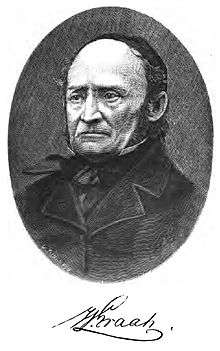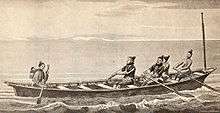Wilhelm August Graah
Wilhelm August Graah (1793–1863) was a Danish naval officer and Arctic explorer. Graah had mapped areas of West Greenland when he, in 1828–30, was sent by King Frederick VI of Denmark on an expedition to the unmapped eastern coast with the purpose to search for the lost Eastern Norse Settlement.
Wilhelm August Graah | |
|---|---|
 | |
| Born | 24 May 1793 Copenhagen, Denmark |
| Died | 16 September 1863 Copenhagen, Denmark |
| Allegiance | |
| Service/ | |
| Years of service | 1811–1850 |
| Rank | Captain |
| Awards | Knight's Cross of the Order of the Dannebrog |
Expedition

The expedition set out from Copenhagen in the brig Hvalfisken, but - once arrived in Greenland - used umiaks able to navigate in the waters between the coast and the sea ice of southeastern Greenland. In 1829, the expedition reached Dannebrog Island (65° 18' N), where it was stopped by ice.[1] They wintered at Nugarlik (63° 22' N) and returned to the settlements on the west coast of Greenland in 1830.[2] Two naturalists participated - the geologist Christian Pingel and the botanist Jens Vahl. Graah published an account of the exploration.[3]
Graah named the southeastern coast of Greenland King Frederick VI Coast and mapped about 550 km of formerly uncharted territory. Although he had been asked to reach 69°, Graah fell short of his goal of going further north owing to innumerable hardships. He made numerous contacts with the now extinct Southeast-Greenland Inuit, describing in detail some of their customs and way of life.[4]
Honours
The Graah Mountains (Graah Fjelde) and Graah Fjord in the King Frederick VI Coast of SE Greenland, as well as Cape Graah in King Christian X Land were named after him.[5]
Literature
References
- Mason, Herbert B. (1908). Encyclopaedia of ships and shipping. The Shipping Encyclopaedia. p. 38.
- "Page:Encyclopædia Britannica, Ninth Edition, v. 19.djvu/336 - Wikisource, the free online library". en.wikisource.org. Retrieved 2020-05-30.
- Graah, W. A. (1832). Undersøgelses-Reise til Østkysten af Grønland, efter kongelig Befaling udført i Aarene 1828-31 [Exploration of the East Coast of Greenland, by royal order executed in the years 1828-31] (in Danish). Copenhagen.
- Spencer Apollonio, Lands That Hold One Spellbound: A Story of East Greenland, 2008 pp. 29-40
- Greenland Pilot - Danish Geodata Agency, p. 22